IN A SPIN – Part 2
It’s been a dire end to the river season and my exploits to catch pike have been very unproductive. A friend of mine has done quite well fishing livebaits just off the side of the river in the slacks where you’d expect pike to be and has caught fish to 19lbs. However, they haven’t responded quite so well to lures and of those that have, they’ve been on and then, because I have been fumbling for my camera, I lost them.
HOOKS
On with the lessons though and to begin with the first thing I do with all new lures, no matter what type, is to crush down the barbs on all the hook points. I do this as much for my own safety as for that of the pike and perch. Who wants to end up a session like this:
No laughing matter really, is it? Another thing you should always do is wear protective glasses, either Polaroid’s that will help you see through the surface film better, even in low light conditions, or just general safety glasses from hardware stores. And don’t forget to wear a hat too!
You may think that a hook with a crushed down barb is less likely to hold a pike than one with the barb intact. That may be correct in certain hook-up situations, but generally in many areas of a pike’s mouth the barb tears the flesh and then will have little effect in holding the fish any better. Without a full barb, the hooks are also easier to extract especially when deep hooked or if the hook gets caught in the gill area.
So the down side of crushing barbs is, you may lose the odd fish or three, but I’d rather that than struggle with a deeply hooked fish and then have to fight the barbs as well. Although no doubt some will have their own thoughts on this. (Grabs tin hat and waits for attached thread.)
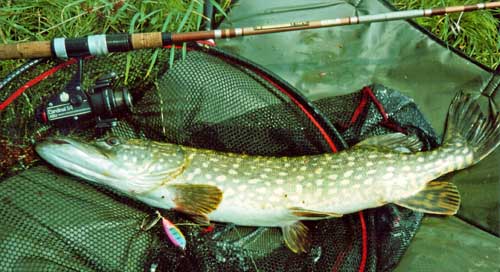
Small jack taken on a Bete Lotto
The other element you may wish to give some thought to is the hook itself. On many American lures you will find galvanised metal or bronzed hooks that bend straight with a reasonable pull. By this I don’t mean you will lose any fish because of them straightening, very few if so, but I do mean that if you do get caught on an underwater snag, it may just be possible to retrieve the lure by pulling so hard you do straighten the hook.
Some of the best hooks for this are Eagle Claw hooks, galvanised to protect them from rust as well. I’m not going down that road again of what strength of line you will need to achieve this, it’s up to you, but very, very strong line indeed. However, a lot of lures come with large and very strong forged hooks with flattened sides and all that I can say is if they’re Mustads, you haven’t a hope of getting them back unless you are using 200+lbs line. It’s almost impossible to straighten some of them.
So, if you want to be fairly sure of pulling out of snags, I would suggest changing suspiciously strong forged hooks to Eagle Claw or similar. Be prepared to pay quite a bit though as most styles and sizes come in packs of 50 and you’ll pay around a tenner a pack.
SPINNERS, SPINNERBAITS & BUZZBAITS
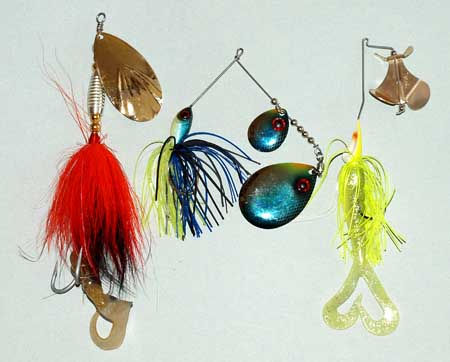
From left to right: a standard blade spinner, a spinnerbait, and a buzzbait.
Perhaps this is the biggest group and from my point of view, they are some of the most productive lures of all.
When I first started spinning, all you could buy were Voblex (?) lures and the Rublex Ondex spinners from France. As a spotty teenager I was working for the C.W.S. (this was the wholesale part of the Co-op, not your normal retail store) in Manchester and within their hardware division they had a sports department that sold fishing tackle. Eventually it was decided to close the department and they got rid of most of their rods and reels. The rods were pretty good, but most were offered to the individual societies rather than employees.
However, they were left with boxes of Voblex and Rublex spinners and one of the managers who knew I was an angler offered me about ten boxes with a dozen lures in each, all different sizes as well. I gave a lot to my mates to try out and gave some of them a good go myself, but I suppose with my lack of experience in spinning the results were poor. Or to be precise, zilch! I had kept some into the 70s, but eventually most ended up in the bin replaced by the far superior (in my opinion) Abu lures.
Even those Abu lures were small by comparison to what you can get these days, but at least they worked and many a good jack pike was had on an Abu Reflex.
Spinners to me are those that work on a blade rotating around a central wire, like the Reflex. Spinnerbaits are a newer introduction from the USA and are more like the “coat-hanger” style V lure with blades on one stem and some rubber tassels covering a single hook on the other. Buzzbaits are similar to Spinnerbaits, but instead of rotating blades they have a paddle to create a disturbance on the surface of the water. See photo for differences.
To begin with though, I want to feature the Harris Mean Hornet.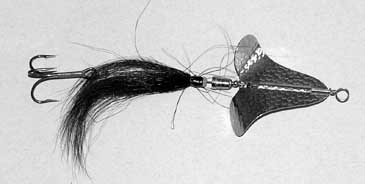
Mean Hornet
This particular lure was recommended by Barrie Rickards in his video (see part 1) and that’s when I tracked it down and bought some, maybe nine or ten years ago now. Since then it has accounted for as many pike as all other lures put together. It combines the qualities of a buzzbait with those of a standard spinner, but the best attribute of all is that it works!
One tactic I learnt with this bait was to cast it beyond your target area and bring it back as fast as you can so that it flies across the surface of the water. Repeat the cast and do the same again. Now cast it to the same spot again, but this time count it down to the depth you wish to fish it and retrieve it as slowly as possible otherwise will ride up in the water to the surface. If there’s a pike in that area you will nail it.
BLADED SPINNERS
These are the normal lures you would think of as spinners. Typical patterns are the ABU Reflex and Droppen or the Mepps lures as well as some new ones from Fox and Blue Fox. For pike buy the largest sizes available, at least 8 grams in weight, but that in itself is no indication of the area of the blade and body. If you can get them with any fur or fluff on the hook then that does act as an extra attractor.
These are some of my favourites:
Mepps Aglia Platinum in size 4 red This is an excellent lure for pike and will take some larger perch as well. Also, the Aglia Hot Tiger in size 5 or the Fluo in size 4, the colour is up to you, but I had a yellow that worked well. I must replace it sometime, but note that all of the above are very similar apart from colours of the blades and bodies. Their action in the water is great, but normally fished with a steady slow retrieve and even better if you can get them with a bit of fur or feather on the hook.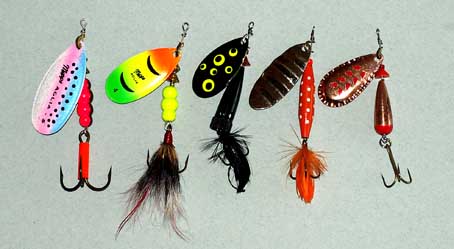
From l to r: Mepps and a dressed Mepps, Abu’s Bullet, Reflex and Droppen.
I have lost count of the number of Abu lures I have owned and lost on rocks in weirpools or underwater logs yet I still keep buying them because they work so well. The Reflex started it all for me and was a replacement of the old Flex lure; I still have one last Flex that I am now reluctant to use in case I lose it. It is tatty, has no body colour although that is easy to repaint, but whenever I put it on the end of the line it inevitably catches perch after perch. I often wonder why they discontinued the Flex, but they did.
So the Reflex is now the one that I would recommend, but again, for pike you need the biggest available. For perch, chub and trout, size is not so important. Did I say trout? Well, we used to fish one of the northern reservoirs with spinners for trout during the close season, spinning was allowed. Reflex was the best after Flex and there was also one called the Sonette with little scoops in the blade to create extra turbulence.
I forget the year, could have been 1971 or 72 when Abu introduced the Droppen. This has a wavy edge to the blade and boy was it a success! It casts really nicely and you can retrieve it very slowly indeed, in fact sometimes just the current in the river will keep the blade moving. I am not so keen on the black blades with spots that are sold; I prefer the shinier ones with coloured spots that we originally started with. I have one that has a small rubber fish in tow, but to be honest, it has never caught me a single fish.
Moving up in size I have one or two gigantic spinners, one of which is similar to these (mine is now discontinued) Fox Predators You might want to have a good look through many of the lures available from www.tackleshop.co.uk, there are some nice Fox ones and some by Rapala and Grauvell at very nice prices. Whilst your in that site, take a look at spinnerbaits.
SPINNERBAITS
These are an introduction from the USA and rather than explain take a look at this:
Ok, so now you know what a spinnerbait looks like and believe me they are fantastic lures to fish with. Their main benefit is that you can fish them through the thickest of weed and they just pull straight through mainly because they only have one hook and that travels upturned, away from the bottom. You can even bounce it across the bottom without fear of getting it caught up. Well, most of the time.
I started with spinnerbaits by acquiring some made by the US company Northland, called Reed-Runners. However, Harris no longer supply them, but you can get some very good ones from Fox too (see here). Keep an open mind on the weights, heavy ones are good and get you down fast, but the lighter ones can also be very productive. Just make sure you have a good selection of colours including some very dark or black and even white and silver ones.
After a while the rubber skirts or tassels may wither away or just get chewed of by so many takes. Don’t worry, get yourself some rubber grubs or shads and stick one on the hook instead of the skirt (see picture). They work just as well if not better in some circumstances and there’s nothing to stop you adding a small rubber grub to a brand new one combining skirt and grub together. Keep a lookout on Ebay also for the old, now discontinued, Toothy Critter Twin Spin Motivator that occasionally turn up. You can really feel these working for you.
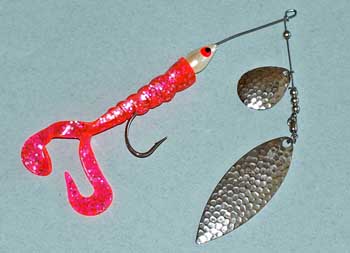
Northland Reed Runner modified with a latex grub.
To fish spinnerbaits you can use a steady slow retrieve or sink and draw and as the film below on the Colorado Spinnerbait shows because when they sink they flutter down with their spoons still working. If you are fishing from a boat or have really deep water directly in front of you, you can use these baits like pirks, lifting them and letting them sink then lifting again. Any pike in the area will attack these baits, but be sure to strike hard and firm because you only have one hook to catch it with. Just mind that the lure. doesn’t leave the water and stick in your nose or eye.
BUZZBAITS
Other than the Mean Hornet, already mentioned, which is a cross between a buzzbait and a standard spinner, I don’t use a lot of these. They do ride high in the water and for that I would prefer the Hornet. However, if you see one (Harris have the Northland Buzzard) you might want to try one just to see how they behave. They will catch fish, that’s for sure, but my own opinion is that for most of the time the one I have stays where it is, in the box.
For fishing it watch this video:
Don’t forget that these videos of Doug Hammon are directed at American bass fishing so when you think pike, slow down! Pike are lazy creatures to my mind and don’t like to expend too much energy to catch their prey fish. A short fast burst is their main form of attack and if that lure is passing too quickly, old pikey won’t even bother. So slow down and give them a chance.
NEXT TIME – THE BIG CON!










